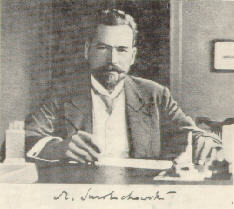Prominent Poles
Marian Smoluchowski (aka Marian Ritter von Smolan Smoluchowski), scientist, pioneer of statistical physics, mountaineer.

Born: 28 May 1872, Vorderbrühl, Austro-Hungarian Empire (presently Austria)
Died: 5 September 1917, Cracow, Austro-Hungarian partition of Poland (presently Krakow, Poland)
Summary. In his obituary, Professor Wladyslaw Natanson wrote: "With great pleasure I would revive the charm of his life, knightly softness of his heart, combined with exquisite kindness. I wish I could reconstruct the odd appeal of his personality, recall how restrained he was, modest, and beautifully timid, yet always full of pure, almost unintentional joy."
Early days. Marian's father, Wilhelm, had trained as a lawyer then worked in the Imperial Office as a high ranking member of Franz Joseph's privy council. His mother was Teofila Szczepanowska. During 1880-1890 he attended Collegium Theresianum in Vienna, a secondary school for the education of higher officials. In 1890 Smoluchowski graduated being awarded his certificate with distinction, and entered the University of Vienna to study physics. There he was taught by Stefan, Weyr and Exner. He published his first paper on the internal damping of liquids in 1893 and was awarded his doctorate (with the highest distinction) in 1895 for his thesis Acoustical studies of elasticity of soft materials. From November 1895 to July 1896 he undertook research on heat radiation in Paris at the laboratory of Gabriel Lippman at the Sorbonne. He spent the summer of 1896 in England, at Eastbourne and London then, from September 1896 to April 1897, he was in Glasgow undertaking research on X-rays and uranium radiation in the laboratory of a famous physicist, William Thomson (Lord Kelvin). Leaving Glasgow, Smoluchowski then spent four months undertaking research in Berlin at the laboratory of Emil Warburg where he discovered the temperature discontinuity in rarefied gases. In 1898 he became a privatdozent at the University of Vienna but a year later he accepted a position as a privatdozent at the University of Lwow.
Work. He moved to Lwow (presently Lviv, Ukraine) in 1899, where he took a position at the University of Lwow. In 1901 he married Zofia Baraniecka. They had two children: Aldona (1902-1984) and Roman (1910-1996). In 1913 Smoluchowski moved to Cracow to take over the chair in Experimental Physics Department. After WWI had broken out, the conditions for work became unusually difficult, and even the spacious and modern Physics Department edifice, built by Witkowski a short time before, had been turned into a hospital by military authorities. Deprived of the premises, Smoluchowski was forced to work in the former apartment of the late Professor Karol Olszewski. During the experimental physics lectures carried out by Smoluchowski, making use of even the simplest demonstration equipment was virtually impossible. Smoluchowski performed a great deal of academic teaching: he lectured in experimental physics and had numerous students. His wide non-professional interests included skiing, mountain climbing in the Alps and Tatra Mountains, watercolor painting, playing the piano. Smoluchowski died in 1917 the victim of a dysentery epidemic. Societies = Copernicus Society of Natural Scientists, Polish Academy of Sciences and Letters
Achievements. His scientific output included fundamental work on the kinetic theory of matter. In 1904 he was the first who noted the existence of density fluctuations in the gas phase and in 1908 he became the first physicist to ascribe the phenomenon of critical opalescence to large density fluctuations. His investigations also concerned the blue color of the sky as a consequence of light dispersion on fluctuations in the atmosphere, as well as explanation of Brownian motion of particles (independently of Albert Einstein). At that time Smoluchowski proposed formulae which presently carry his name. Smoluchowski presented an equation which became an important basis of the theory of stochastic processes.
Honors and awards. 1901 Doctor honoris causa of law (LLD) at the Glasgow University; 1903 full („ordinary”) professor of theoretical physics at Lwów University; 1906-1907 President of the Copernicus Society of Natural Scientists in Lwow; 1908 Haitnger's prize of the Vienna Academy of Sciences for the theoretical explanation of the Brownian motion; 1913 May, full professor of experimental physics at the Jagellonian University, Kraków; 1916 awarded „Silber Edelweiss” by the German and Austrian Alpine Society; 1916/17 Dean of the Faculty of Philosophy at Jagellonian University; 1917 Full member of the Academy of Sciences and Letters in Cracow; 1917 June 15, elected rector (president) of the Jagellonian University.
This article uses mostly material from the Wikipedia article "Marian Smoluchowski" licensed under the GNU Free Documentation License. :
Wikipedia
Other sources include:
MacTutor (O'Connor, Robertson)
University of Lublin (Alojzy Burnicki)
Return to home page:
Prominent Poles
